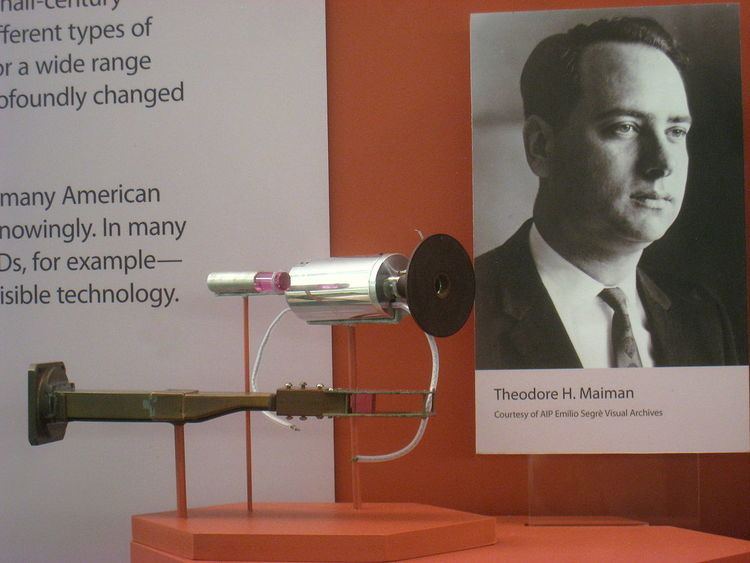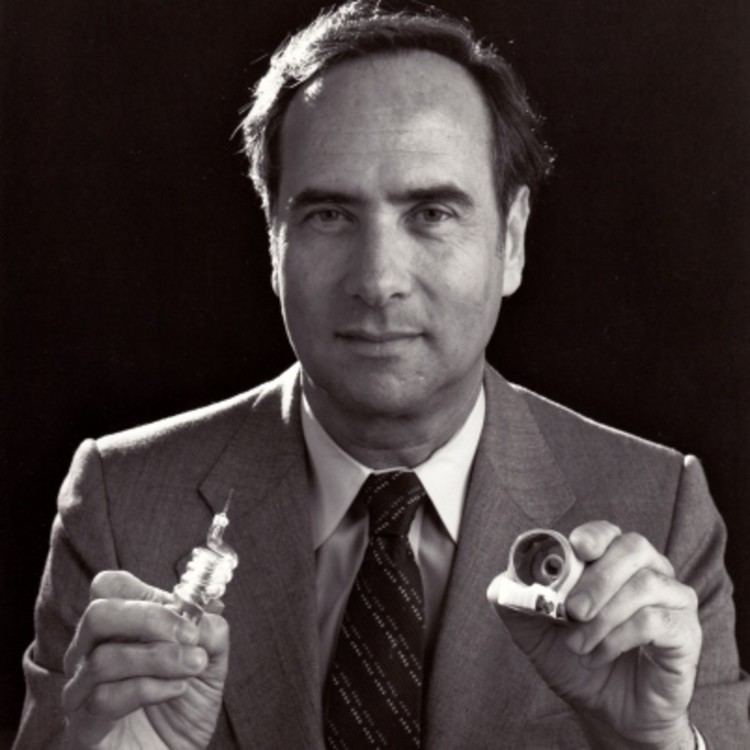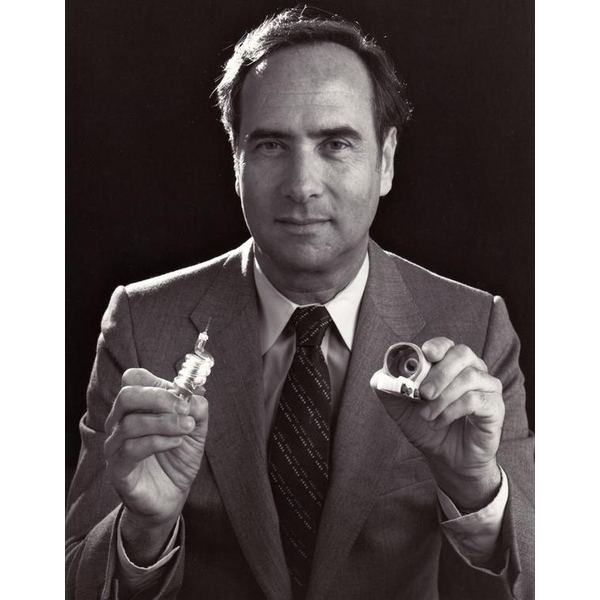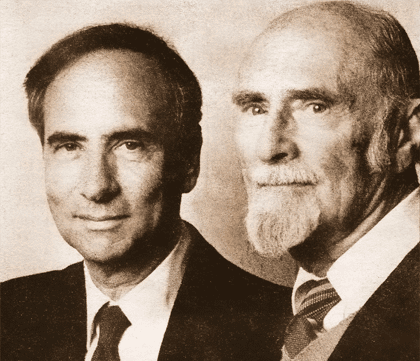Books The laser odyssey Role Physicist | Name Theodore Maiman | |
 | ||
Born Theodore Harold MaimanJuly 11, 1927Los Angeles, California, U.S. ( 1927-07-11 ) Institutions Hughes Research LaboratoriesQuantatronKorad Corporation Alma mater University of ColoradoStanford Known for Inventing, Demonstrating, and Patenting the World's First LASER Notable awards Stuart Ballantine Medal (1962)Oliver E. Buckley Condensed Matter Prize (1966)Wolf Prize in Physics (1983)Japan Prize (1987) Education Stanford University (1955), Stanford University (1951), University of Colorado Boulder (1949), Columbia University Fields Physics, Electrical engineering Similar People Charles H Townes, Gordon Gould, Nikolay Basov, Alexander Prokhorov, Willis Lamb | ||
Theodore Harold "Ted" Maiman (July 11, 1927 – May 5, 2007) was an American engineer and physicist credited with the building of the first working laser. Maiman's laser led to the subsequent development of many other types of lasers. The laser was successfully fired on May 16, 1960. In a July 7, 1960 press conference in Manhattan, Maiman and his employer, Hughes Aircraft Company, announced the laser to the world. Maiman was granted a patent for his invention, and he received many awards and honors for his work. Maiman's experiences in developing the first laser and subsequent related events are described in his book, The Laser Odyssey.
Contents

Life and career

Maiman was born in Los Angeles, California to Abraham "Abe" Maiman, an electrical engineer and inventor, and Rose Abramson. At a young age his family moved to Denver, Colorado, where he helped his father with experimentation in a home electronics laboratory. In his teens Maiman earned money by repairing electrical appliances and radios, and after leaving high school was employed as a junior engineer with the National Union Radio Company at age 17.

Following a year's service in the U.S. Navy at the end of World War II, he earned a B.S. in Engineering Physics from the University of Colorado Boulder. Maiman then went on to graduate studies at Stanford University where he earned an M.S. in Electrical Engineering in 1951 and a PhD in Physics in 1955.

His doctoral thesis in experimental physics, under the direction of physicist Willis Lamb, involved detailed microwave-optical measurements of fine structural splittings in excited helium atoms. He also devised laboratory instrumentation for Lamb's experiments. Maiman published two articles jointly with Lamb in Physical Review, the second of which was based on his own thesis research. His thesis experiment was instrumental in his development of the laser.

In 1956 Maiman started work with the Atomic Physics Department of the Hughes Aircraft Company (later Hughes Research Laboratories or HRL Laboratories) in California where he led the ruby maser redesign project for the U.S. Army Signal Corps, reducing it from a 2.5-ton cryogenic device to 4 pounds while improving its performance. As a result of this success Maiman persuaded Hughes management to use company funds to support his laser project beginning in mid-1959. On a total budget of $50,000, Maiman turned to the development of a laser based on his own design with a synthetic ruby crystal, which other scientists seeking to make a laser felt would not work.

On May 16, 1960, at Hughes' Malibu, California, labs, Maiman's solid-state pink ruby laser emitted mankind's first coherent light—with rays all the same wavelength and fully in phase. Maiman documented his invention in Nature and published other scholarly articles describing the science and technology underlying his laser.
Maiman had begun conceptualizing a solid-state laser design even before he undertook the maser project at Hughes. Moving the microwave frequency of masers up the electromagnetic spectrum 50,000-fold to the frequency of light would require finding a feasible lasing medium and excitation source and designing the system. Other major research groups at IBM, Bell Labs, MIT, Westinghouse, RCA and Columbia University, among others, were also pursuing projects to develop a laser.
Their work was stimulated by a 1958 paper by Arthur L. Schawlow and Charles H. Townes offering theoretical analysis and a proposal for a gaseous system using potassium vapor excited by a potassium lamp. However, Maiman identified multiple flaws in the Schawlow-Townes proposal and pursued his own solid-state design. His successful design utilized synthetic pink ruby crystal as the lasing medium and a helical xenon flash lamp as the excitation source. As Townes later wrote, "Maiman's laser had several aspects not considered in our theoretical paper, nor discussed by others before the ruby demonstration."
Following his invention of the laser, in 1961 Maiman and seven colleagues departed Hughes to join the newly formed Quantatron company, which grew in-house ruby crystals for lasers. In 1962 Maiman founded and became the president of the Korad Corporation, which manufactured high-power ruby lasers. After Korad was fully acquired by Union Carbide in 1968, Maiman left to found Maiman Associates, a venture capital firm. In 1971 Maiman founded the Laser Video Corporation, and from 1976 to 1983 he worked as vice president for advanced technology at TRW Electronics (now Northrop Grumman). He later served as consultant to Laser Centers of America, Inc. (now LCA-Vision Inc.) and director of Control Laser Corporation. Maiman continued his involvement in laser developments and applications. In addition to his patent for the first working laser, Maiman authored a number of patents on masers, lasers, laser displays, optical scanning, and modulation.
Awards and recognition
Maiman received numerous prizes, awards, and accolades over the years for his development of the first laser. He was given membership in both the National Academies of Sciences and Engineering. He was made a Fellow of the American Physical Society, the Optical Society of America (OSA), and the Society of Photo-Optical Instrumentation Engineers (SPIE). In 1962 Maiman was awarded the Franklin Institute's Stuart Ballantine Medal for physics.
In 1966 Maiman received the American Physical Society's Oliver E. Buckley Condensed Matter Prize and the Fannie and John Hertz Foundation Award for distinguished contribution in the field of science, presented in a White House ceremony by President Lyndon B. Johnson. In 1976 Maiman was awarded the Optical Society of America's R.W. Wood Prize for "Pioneer Development of the First Laser". He was the recipient of the 1983/84 Wolf Prize in Physics and was also inducted into the National Inventors Hall of Fame that year. In 1987 Maiman was awarded the Japan Prize in Electro-Optics for "realization of the world's first laser." In 1994 he was inducted as an honorary fellow of the Royal College of Surgeons of England, the only non-physician, non-royal member. Time magazine cited Maiman's invention of the laser as among the twenty most important technological developments of the 20th century. Many universities granted Maiman honorary degrees, with the last from Simon Fraser University in 2002.
Recognition for Maiman and his laser invention continued posthumously. In a 2007 obituary testimonial, maser co-inventor Charles H. Townes described Maiman's 1960 Nature article on his laser as "probably more important per word than any of the papers published by Nature over the past century." The annual Theodore Maiman Student Paper Competition was established in 2008, endowed by major laser groups, and is administered by the OSA Foundation. In 2010 numerous events were staged worldwide by major scientific and industry photonics organizations to celebrate the 50th anniversary of Maiman's first laser and subsequent lasers under the umbrella of LaserFest. Related to these events, the U.S. Congress passed a resolution celebrating the invention of the laser and citing Maiman. Also in 2010 Maiman's laser achievement was recognized as an IEEE Milestone, and the American Physical Society presented Hughes Research Laboratories with a plaque to commemorate the historic site of the world's first laser.
In 2011 Maiman was recognized by Stanford University as a "Stanford Engineering Hero," citing his "rare blend of advanced training in physics and engineering combined with significant laboratory experience." In 2014 the National Academy of Sciences published a biographical memoir of Maiman including a tribute by Nick Holonyak, Jr.
Death
Maiman died from systemic mastocytosis on May 5, 2007 in Vancouver, Canada, where he lived with his wife, Kathleen.
